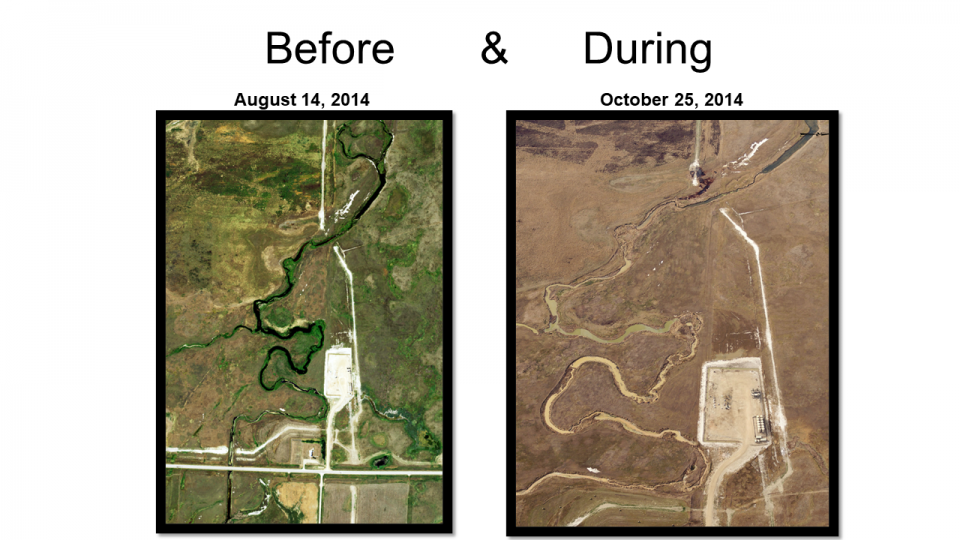Pipeline Rupture Caused 29 Million Gallon Spill Over 143 Days Before Discovery
The Department of Justice Thursday filed criminal charges under the Clean Water Act against Summit Midstream Partners LLC, a North Dakota pipeline company, according to officials.
It discharged 29 million gallons of produced water from its pipeline near Williston, North Dakota, over the course of nearly five months in 2014-2015, authorities stated.
The discharge of more than 700,000 barrels of “produced water” – a waste product of hydraulic fracturing – contaminated land, groundwater, and over 30 miles of tributaries of the Missouri River.

The spill, believed to be the largest inland spill in history, was visible in photographs taken by satellites orbiting the earth.
In addition to the criminal charges, the United States and the State of North Dakota filed a civil complaint against Summit and a related company, Meadowlark Midstream Company LLC, alleging violations of the Clean Water Act and North Dakota water pollution control laws.
Under parallel settlements resolving the criminal and civil cases, the company has agreed to pay a total of $35 million in criminal fines and civil penalties.
“Summit prioritized profits over the environment. The company’s disregard for pipeline safety resulted in pollution of the environment on a massive scale over 143 days,” said Assistant Attorney General Todd Kim of the Justice Department’s Environment and Natural Resources Division. “Summit’s conduct was criminal and its failure to immediately report the discharge a felony. This resolution holds the company financially accountable, requires enhanced compliance measures to prevent future spills, and provides compensation for North Dakota’s damaged natural resources.”
If the court accepts the plea agreement, Summit will pay $15 million in federal criminal fines for negligently causing the continuous spill, failing to stop it and deliberately failing to make an immediate report as required.

Summit has further admitted that it knowingly did not share all relevant information regarding the volume and duration of the spill and that its reports to federal and state authorities “were incomplete and misleading,” in papers filed in court.
Summit eventually reported 70,000 barrels over a 10-day period despite an internal analysis showing the discharge was more than 700,000 barrels over 143 days. Under the terms of the proposed plea agreement, Summit will serve three years of probation in which comprehensive remedial measures are required.
Under the proposed civil settlement, Summit, Meadowlark, and a third related company, Summit Operating Services Company LLC, will pay $20 million in civil penalties, perform comprehensive injunctive relief, clean up the contamination caused by the spill and pay $1.25 million in natural resource damages to resolve the civil case.
Summit has spent over $50 million to date to clean up the spill under state oversight; ongoing remediation efforts under the civil settlement are expected to continue over the next several years.
The civil settlement further requires Summit and Meadowlark to take concrete steps to prevent future discharges, including stringent pipeline installation, operation, and testing requirements; a centralized computational pipeline monitoring system; spill response planning and countermeasures; an environmental management system; and data management and training measures.
Independent third-party audits are required to ensure that certain injunctive measures are properly developed and implemented. These compliance measures were made a condition of Summit’s probation in the proposed criminal plea agreement. The companies have also agreed to enter into a related administrative settlement with the North Dakota Industrial Commission.
Summit continued pumping produced water through the pipeline in 2014 to 2015 despite multiple warning signs that the line had ruptured:
- Aug. 17, 2014. Real-time pressure data collected by Summit showed a significant pressure drop, indicating a rupture had occurred.
- Oct. 14, 2014: Summit’s construction manager raised a concern about “extreme low pressure on the pipeline.” The facilities engineer responded: “Not good. We may want to consider shutting it down.” Summit continued to operate the line.
- Nov. 4, 2014: the third-party operator of the injection well at the end of the pipeline (Company A) informed Summit that 115,000 barrels (4,830,000 gallons) of produced water were missing for the month of October, which is approximately 3,700 barrels (155,400 gallons) per day.
- Dec. 3, 10, and 16, 2014: Company A followed up with Summit about the produced water discrepancy, having received no response to its previous inquiries. During this time, Company A confirmed the accuracy of its injection well meters and informed Summit that the discrepancy had risen to 4,900 barrels per day.
- Jan. 6, 2015: A Summit employee walked the line, finally identifying the rupture.
The resulting 700,000-barrel discharge of produced water contained crude oil, chloride, sodium, ammonia, aluminum, arsenic, boron, copper, nickel, selenium, zinc, barium, benzene, and thallium, among other contaminants.
Produced water is a waste product of oil extraction and can be toxic to plants, fish, and other aquatic wildlife. It is also harmful to humans.


